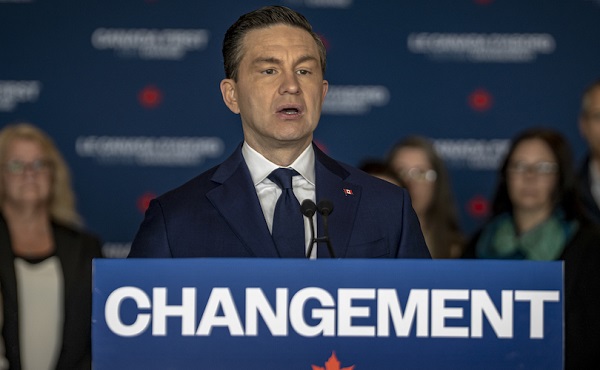Alberta
Energy East May be the Nation Building Mega-Project Canada Needs Right Now

From EnergyNow.Ca
By Jim Warren
Is it Time to Put Politics Aside for Team Canada? – Jim Warren
People on the prairies who understand the value of a flourishing oil and gas sector are hopeful the election of a Conservative government will sweep away the barriers that blocked the Northern Gateway and Energy East pipelines. Some optimistic industry analysts suggest a project similar to Northern Gateway may be doable but concede that reviving Energy East would probably be a bridge too far.
It is getting difficult to recount exactly how many times Quebec’s demands for special treatment have disrupted national unity. Quebec’s rejection of Energy East was the most recent assault on national cohesion to anger large numbers of people on the prairies. It amounted to sticking a finger in the eye of the oil-producing provinces. And while the Poilievre Conservatives are set to win the next election, their victory won’t signal a big change in attitudes about the environment in Quebec.
Politicians from Quebec argue over which of their parties can claim it hates pipelines the most. Bloc Québécois leader, Yves-François Blanchet brags about the prominent role his party played in killing Energy East. His boasting actually drew the ire of Quebec Liberals and environmental groups in 2019. They claimed the Bloc was taking credit for their work. The 338Canada website, has the anti-oil Bloc Québécois winning 45 of the 78 federal seats in Quebec in the upcoming federal election.
Provincially, the Coalition Avenir Québec (CAQ) government is marginally more reasonable to deal with. It claims to stand for Quebec’s national autonomy as opposed to outright separation. Quebec premier, François Legault, says the west would do well to behave more like politicians from his province when dealing with Ottawa. He makes a good point.
Revisiting just how eminently reasonable the original Energy East proposal actually was suggests many Quebec politicians are immune to common sense. If the Energy East proposal wasn’t acceptable to the overly zealous activists who influence environmental policy in the province, why would we expect a different response in the near future?
There are, however, coercive options that might work. Premiers from Alberta and Saskatchewan have proposed withholding a portion of Quebec’s annual equalization payment in response to its lack of cooperation on building a pipeline to tidewater on the Atlantic coast. Unfortunately that option would require a constitutional amendment, and those have proven to be extremely difficult to engineer.
Alternatively, prairie governments might encourage Enbridge to shut down its Line 9 pipeline which has the capacity to transport up to 300 barrels per day (bpd) of western oil to Montreal. That sort of move would require getting industry players on side–including Enbridge and Suncor, who owns a 137,000 bpd capacity refinery in Montreal. It is encouraging to recall that Peter Lougheed faced little in the way of industry opposition in the 1970s when he cut oil shipments to Central Canada by 10%.
Quebec’s past behavior pretty much guarantees the province would threaten separation if confronted with the loss of its equalization welfare ($14 billion for fiscal 2023-24). They might be less concerned about getting a pipeline from the west turned off—they seem to prefer tanker ships over pipelines.
Many westerners are weary of Quebec’s separation blackmail. Some of those who have run out of patience say, “next time they threaten to go, just tell them not to let the door hit them on the ass on their way out.”
The cancellation of the Energy East pipeline was viewed on the prairies as rejection of a project that would generate greater national harmony. It was seen as a nation building exercise of benefit to Quebecers, people from the Maritimes, Ontario and Western Canada. Westerners mistakenly assumed even environmentally sanctimonious Quebecers would recognize the benefits of obtaining more of their oil from pipelines rather than via marginally risky railways and ocean going tankers.
Following the 2013 Lac-Mégantic rail disaster, people from western Canada’s oil patch naively assumed approval of Energy East was a no brainer. The disaster killed 47 people and destroyed downtown Lac- Mégantic. It was caused by the derailment and explosion of a train hauling oil tanker cars. It seemed reasonable to imagine Quebecers would happily purchase safer, less expensive Canadian oil transported by pipeline.
Energy East would have been the longest pipeline in North America. It was to run from Alberta to Saint John, New Brunswick. The plan was to convert 2,900 miles of existing natural gas pipeline into an oil pipeline, build 1,900 miles of new pipeline and make a $300 million upgrade to an Irving oil terminal in New Brunswick. It was a visionary project reminiscent of the building of the transcontinental railway and the original TransCanada pipeline.
The pipeline would be capable of transporting 1.1 million bpd. No more than 400,000 bpd would be required to replace the foreign oil being imported by tanker and rail. The remaining 600,000 barrels could be exported to new international customers for Canadian oil. The value of those new export revenues would conceivably approach $15 billion annually.
It is worth remembering the influential role Quebec Liberals played in opposing Energy East. Montreal’s Mayor Denis Coderre, was a former Liberal cabinet minister who led the Montreal Municipal Community (MMC) a coalition of 82 Montreal area municipal governments. As much as anything, the MMC’s strident opposition to Energy Easy in January of 2016 foretold TransCanada’s October 2017 cancellation of the pipeline.
Inspiration for cancelling the pipeline was provided by Quebec’s robust environmental lobby—led by activists like Steven Guilbeault. Polls conducted at the time showed the Quebec politicians who opposed Energy East had the support of 60% or more of the public. The pipeline was similarly denounced by premier Philippe Couillard and Quebec’s Liberal government at the time. While the southwest corner of B.C. has typically been thought of as the home of Canada’s Greens, in Quebec the Liberals are the party preferred by environmental activists.
Liberals in Ottawa remained officially neutral during the Energy East controversy but were unofficially cheering for the pipeline’s cancellation from the sidelines.
One of the biggest challenges to confront an effort to revive the project would be finding willing investors. TransCanada walked away financially bruised and who wants to be similarly burnt? And, the Trans Mountain example casts a dark shadow on the idea of a government-owned line.
Trying to convince Quebecers, especially young adults, about the value of new oil pipelines seems like a fool’s errand. Given that only 50% of 16-20 year-olds in Quebec have a driver’s license, it could prove difficult convincing them about the importance of petroleum to Canada’s transportation system and economic health.
No less discouraging is the fact that Quebec’s environmental movement remains dedicated to killing the petroleum and natural gas industries on behalf of combatting climate change.
Yet, oddly enough there have been surprising signals coming out of Quebec in recent years suggesting regular Quebecers don’t share the same level of anti-oil and anti-pipeline enthusiasm as their province’s politicians and environmentalists. Perhaps this is something worth looking into before giving up entirely on the idea of a pipeline to Atlantic tidewater.
Alberta
Low oil prices could have big consequences for Alberta’s finances

From the Fraser Institute
By Tegan Hill
Amid the tariff war, the price of West Texas Intermediate oil—a common benchmark—recently dropped below US$60 per barrel. Given every $1 drop in oil prices is an estimated $750 million hit to provincial revenues, if oil prices remain low for long, there could be big implications for Alberta’s budget.
The Smith government already projects a $5.2 billion budget deficit in 2025/26 with continued deficits over the following two years. This year’s deficit is based on oil prices averaging US$68.00 per barrel. While the budget does include a $4 billion “contingency” for unforeseen events, given the economic and fiscal impact of Trump’s tariffs, it could quickly be eaten up.
Budget deficits come with costs for Albertans, who will already pay a projected $600 each in provincial government debt interest in 2025/26. That’s money that could have gone towards health care and education, or even tax relief.
Unfortunately, this is all part of the resource revenue rollercoaster that’s are all too familiar to Albertans.
Resource revenue (including oil and gas royalties) is inherently volatile. In the last 10 years alone, it has been as high as $25.2 billion in 2022/23 and as low as $2.8 billion in 2015/16. The provincial government typically enjoys budget surpluses—and increases government spending—when oil prices and resource revenue is relatively high, but is thrown into deficits when resource revenues inevitably fall.
Fortunately, the Smith government can mitigate this volatility.
The key is limiting the level of resource revenue included in the budget to a set stable amount. Any resource revenue above that stable amount is automatically saved in a rainy-day fund to be withdrawn to maintain that stable amount in the budget during years of relatively low resource revenue. The logic is simple: save during the good times so you can weather the storm during bad times.
Indeed, if the Smith government had created a rainy-day account in 2023, for example, it could have already built up a sizeable fund to help stabilize the budget when resource revenue declines. While the Smith government has deposited some money in the Heritage Fund in recent years, it has not created a dedicated rainy-day account or introduced a similar mechanism to help stabilize provincial finances.
Limiting the amount of resource revenue in the budget, particularly during times of relatively high resource revenue, also tempers demand for higher spending, which is only fiscally sustainable with permanently high resource revenues. In other words, if the government creates a rainy-day account, spending would become more closely align with stable ongoing levels of revenue.
And it’s not too late. To end the boom-bust cycle and finally help stabilize provincial finances, the Smith government should create a rainy-day account.
Alberta
Governments in Alberta should spur homebuilding amid population explosion

From the Fraser Institute
By Tegan Hill and Austin Thompson
In 2024, construction started on 47,827 housing units—the most since 48,336 units in 2007 when population growth was less than half of what it was in 2024.
Alberta has long been viewed as an oasis in Canada’s overheated housing market—a refuge for Canadians priced out of high-cost centres such as Vancouver and Toronto. But the oasis is starting to dry up. House prices and rents in the province have spiked by about one-third since the start of the pandemic. According to a recent Maru poll, more than 70 per cent of Calgarians and Edmontonians doubt they will ever be able to afford a home in their city. Which raises the question: how much longer can this go on?
Alberta’s housing affordability problem reflects a simple reality—not enough homes have been built to accommodate the province’s growing population. The result? More Albertans competing for the same homes and rental units, pushing prices higher.
Population growth has always been volatile in Alberta, but the recent surge, fuelled by record levels of immigration, is unprecedented. Alberta has set new population growth records every year since 2022, culminating in the largest-ever increase of 186,704 new residents in 2024—nearly 70 per cent more than the largest pre-pandemic increase in 2013.
Homebuilding has increased, but not enough to keep pace with the rise in population. In 2024, construction started on 47,827 housing units—the most since 48,336 units in 2007 when population growth was less than half of what it was in 2024.
Moreover, from 1972 to 2019, Alberta added 2.1 new residents (on average) for every housing unit started compared to 3.9 new residents for every housing unit started in 2024. Put differently, today nearly twice as many new residents are potentially competing for each new home compared to historical norms.
While Alberta attracts more Canadians from other provinces than any other province, federal immigration and residency policies drive Alberta’s population growth. So while the provincial government has little control over its population growth, provincial and municipal governments can affect the pace of homebuilding.
For example, recent provincial amendments to the city charters in Calgary and Edmonton have helped standardize building codes, which should minimize cost and complexity for builders who operate across different jurisdictions. Municipal zoning reforms in Calgary, Edmonton and Red Deer have made it easier to build higher-density housing, and Lethbridge and Medicine Hat may soon follow suit. These changes should make it easier and faster to build homes, helping Alberta maintain some of the least restrictive building rules and quickest approval timelines in Canada.
There is, however, room for improvement. Policymakers at both the provincial and municipal level should streamline rules for building, reduce regulatory uncertainty and development costs, and shorten timelines for permit approvals. Calgary, for instance, imposes fees on developers to fund a wide array of public infrastructure—including roads, sewers, libraries, even buses—while Edmonton currently only imposes fees to fund the construction of new firehalls.
It’s difficult to say how long Alberta’s housing affordability woes will endure, but the situation is unlikely to improve unless homebuilding increases, spurred by government policies that facilitate more development.
-

 Alberta19 hours ago
Alberta19 hours agoGovernments in Alberta should spur homebuilding amid population explosion
-

 2025 Federal Election2 days ago
2025 Federal Election2 days agoPoilievre Campaigning To Build A Canadian Economic Fortress
-

 Automotive2 days ago
Automotive2 days agoCanadians’ Interest in Buying an EV Falls for Third Year in a Row
-

 2025 Federal Election2 days ago
2025 Federal Election2 days agoAs PM Poilievre would cancel summer holidays for MP’s so Ottawa can finally get back to work
-

 armed forces1 day ago
armed forces1 day agoYet another struggling soldier says Veteran Affairs Canada offered him euthanasia
-

 conflict1 day ago
conflict1 day agoWhy are the globalists so opposed to Trump’s efforts to make peace in Ukraine?
-

 2025 Federal Election22 hours ago
2025 Federal Election22 hours agoCarney’s budget is worse than Trudeau’s
-

 International18 hours ago
International18 hours agoHistory in the making? Trump, Zelensky hold meeting about Ukraine war in Vatican ahead of Francis’ funeral








